Bird Appearance:
The Bald Eagle has a white head and tail, and a dark brown body and wings. The iris, beak, legs, and feet of this adult bird are also yellow. They are one of the larger birds found in North America. The plumage of the immature Bald Eagle is a dark brown body, wings, head and tail. The size range of the adult Bald Eagle is a wingspan of 168-244 cm, and body masses range from 3.0-6.3 kg (Buehler, 2000). Females are about 25% larger than males, but the sexes are otherwise indistinguishable, and the larger Bald Eagles tend to be found to the north of their range, in Canada and Alaska (Buehler, 2000).
Social Behavior:
During the breeding season and outside of the breeding season, bald eagles have very different social behavior. During the breeding season, bald eagles aggressively defend their territory from intruders. Because of this, they don’t socialize much during the breeding season and mainly only interact with their mate and their offspring (Buehler, 2000). On the other hand, outside of the breeding season, Bald Eagles are very social. Up to hundreds of bald eagles will congregate at communal roost sites at a time. However, even here their interactions are aggressive with birds fighting over food and status within the group (Wilson and Gessaman, 2003). They also have aggressive relations with other birds and mammals. They will steal food from ospreys small mammals and harass/are harassed by Golden Eagles (Buehler, 2000). Bald Eagles mainly migrate alone however sometimes they happen to end up in small groups when migrating. Bald Eagle’s have also been seen to “play” in ways such as passing sticks around and picking up unusual objects. This is especially prevalent in nestlings and its believed this is because “playing” teaches them foraging and other skills they will need in adulthood. Adult “play” behavior is thought to help them improve the skills they need to survive and reproduce (Buehler, 2000). However, it is not certain what this play is for so further research in the area is needed. An experiment to discover the function of Bald Eagle play would be to observe Bald Eagle’s to determine whether those who play more in their youth have better survival skills as adults.
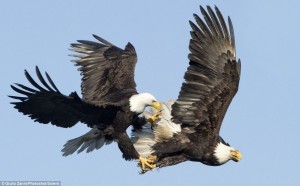
Retrieved from: http://www.dailymail.co.uk/news/article-2388031/Two-bald-eagles-captured-aerial-combat-set-sights-fish.html
Breeding Behavior:
Bald Eagles mating season varies depending on the region where they live and they only have one brood per year (Buehler, 2000). During this breeding season, they have very distinct courtship rituals. The most famous ritual is called the Cartwheel display and it’s where male and female bald eagles will link talons in the sky then proceed to drop from the sky, they unlock their talons at the last minute before they hit the ground. While their courtship mainly occurs in the air, copulation does not. Copulation usually occurs on the round or on a branch near the couple’s nest(Buehler, 2000). Once the bald eagle mates, it is thought to mate for life, unless the bald eagle’s mate dies in which case they will find a new mate. Generally, the Bald Eagles begin building their nests one to three months before the eggs are laid. It’s believed that female Bald Eagles select the site of the nests however, scientists are not certain. Because of this, further research into whether the male or female Bald Eagle selects the nest site is needed. To test this, scientists could observe Bald Eagle behavior across the country when choosing a nest to determine which sex chooses the nest more often. By observing across the country, scientists could also determine whether the sex that chooses the nesting site varies by region. This site is usually a large tree with branches available to be built on however, in treeless regions such as Arizona, Bald Eagles build nests on the ground usually on cliffs or ridges (Buehler, 2000). The male and female Bald Eagles work together to build the nest. They collect sticks to weave into the nests foundation then grasses, mosses and corn stalks are used to fill in the cracks of the nest. The inside of the nest is then lined with soft materials such as Spanish Moss or the downy feathers of the adult birds. These nests are typically used year after year by the Bald Eagle couple so they grow in size over the years but the average nest is between 1.5 and 1.8 meters in diameter. Once eggs are laid, they are typically incubated for around 35 days by both the male and female (Buehler, 2000). This sharing of duties by males and females continues after the eggs hatch, both sexe share parental duties. Both parents will hunt food to bring back to the nest and rip into small pieces to feed to their offspring. Usually eight to fourteen weeks after hatching, these young Bald Eagles will leave the nest (Buehler, 2000).
Habitat and foraging:
The Bald Eagle prefers to nest in old growth forests, with tall trees that are close to large bodies of water (Buehler, 2000). The Bald Eagle does migrate, and prefers to spend its winters in areas with a temperate climate. This migration is caused by the freezing of bodies of water, and lack of access to prefered food sources as a result. The Bald Eagle is most often found in Dutchess County during the winter months, beside the Hudson River (Deorsey and Butler, 2014). This bird often hunts for its food from perches or while in flight. Bald Eagles are considered opportunistic feeders, and while their preferred diet is fish, they will eat a large variety of creatures, such as small mammals, carrion, reptiles and amphibians, crustaseans, and water fowl (Buehler, 2000). Bald Eagles also have many methods for obtaining their food. These include: direct capture, scavenging, and stealing food from other animals (Buehler, 2000).
Citations:
All About Birds. The Cornell Lab of Ornithology. Web. 10 Dec. 2014.
Buehler, David A. 2000. Bald Eagle (Haliaeetusleucocephalus), The Birds of North America Online (A. Poole, Ed.). Ithaca: Cornell Lab of Ornithology; Retrieved from the Birds of North America Online : http://bna.birds.cornell.edu/bna/species/506doi:10.2173/bna.506
DeOrsey, S., Butler, B. A. 2014. Bald Eagle (Haliaeetusleucocephalus). The Birds of Dutchess County, NY: 95.
Wilson, R. and Gessaman, J. 2003. “Two Large Bald Eagle Communal Winter Roosts in Utah.” Journal of Raptor Research 37: 78-83.

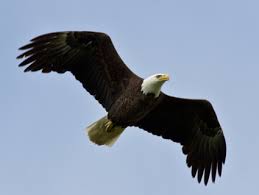
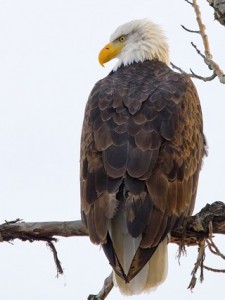
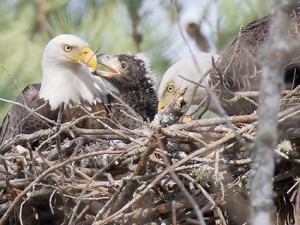
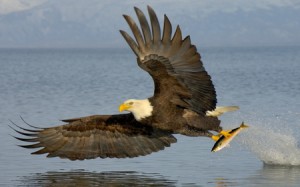
On January 17, I spotted a Bald Eagle perched in a tree at Upton Lake, near Clinton Corners, NY. What a special treat to see, just 30’ from me!